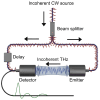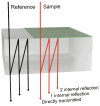Terahertz Cross-Correlation Spectroscopy and Imaging of Large-Area Graphene
- PMID: 36992008
- PMCID: PMC10059862
- DOI: 10.3390/s23063297
Terahertz Cross-Correlation Spectroscopy and Imaging of Large-Area Graphene
Erratum in
-
Correction: Mølvig et al. Terahertz Cross-Correlation Spectroscopy and Imaging of Large-Area Graphene. Sensors 2023, 23, 3297.Sensors (Basel). 2025 Jun 23;25(13):3895. doi: 10.3390/s25133895. Sensors (Basel). 2025. PMID: 40648497 Free PMC article.
Abstract
We demonstrate the use of a novel, integrated THz system to obtain time-domain signals for spectroscopy in the 0.1-1.4 THz range. The system employs THz generation in a photomixing antenna excited by a broadband amplified spontaneous emission (ASE) light source and THz detection with a photoconductive antenna by coherent cross-correlation sampling. We benchmark the performance of our system against a state-of-the-art femtosecond-based THz time-domain spectroscopy system in terms of mapping and imaging of the sheet conductivity of large-area graphene grown by chemical vapor deposition (CVD) and transferred to a PET polymer substrate. We propose to integrate the algorithm for the extraction of the sheet conductivity with the data acquisition, thereby enabling true in-line monitoring capability of the system for integration in graphene production facilities.
Keywords: THz cross-correlation spectroscopy; THz quasi-time-domain spectroscopy; THz time-domain spectroscopy; graphene.
Conflict of interest statement
The authors declare no conflict of interest.
Figures











References
-
- Castro Neto A.H., Guinea F., Peres N.M.R., Novoselov K.S., Geim A.K. The electronic properties of graphene. Rev. Mod. Phys. 2009;81:109–162. doi: 10.1103/RevModPhys.81.109. - DOI
-
- Das Sarma S., Adam S., Hwang E.H., Rossi E. Electronic transport in two-dimensional graphene. Rev. Mod. Phys. 2011;83:407–470. doi: 10.1103/RevModPhys.83.407. - DOI
-
- Avouris P., Dimitrakopoulos C. Graphene: Synthesis and applications. Mater. Today. 2012;15:86–97. doi: 10.1016/S1369-7021(12)70044-5. - DOI
Grants and funding
LinkOut - more resources
Full Text Sources

